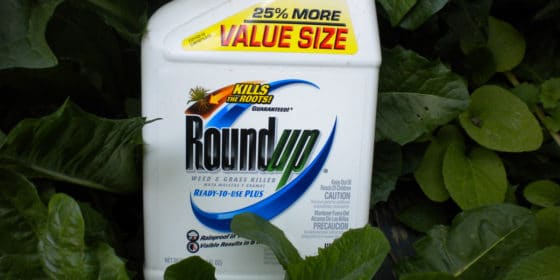(Heather Callaghan) Glyphosate-based herbicides like Monsanto’s Roundup are used the world over. In fact, Roundup is still the most popular and widely used weedkiller in the entire world. Pesticide propagandists are fond of leaning on the idea of “safe” dose, but can there really be a safe dose for a substance that causes breast cancer at parts per trillion?
by Heather Callaghan, May 17th, 2018
A new study shows some startling, adverse health affects in mice given glyphosate in doses at levels considered “safe” by regulatory agencies. This news is more concerning now since recent revelations that glyphosate is in most of our food, FDA emails show.
Three peer-reviewed accepted manuscripts from the pilot phase of the Global Glyphosate Study are available online today (May 16), reports GM Watch. They will be published in the prestigious scientific journal Environmental Health in open access format later in May.
The study used the US Environmental Protection Agency’s acceptable daily dietary exposure level of glyphosate(1) – 1.75 mg per kg of bodyweight per day. The same concentration was given to the rats daily over a 3-month period.
The study was focused on the newborn, infancy and adolescence phases of life. The results reveal that glyphosate-based herbicide (GBH) was able to alter certain important biological parameters, mainly relating to sexual development, genotoxicity, and the intestinal microbiome.
–
The results showed an alteration in some sexual development parameters in rats treated with GBH, especially in females. Moreover, rats treated with GBH presented statistically significant changes of the intestinal microbiome in particular during development.
Concerning genotoxicity, a statistically significant increase was observed in micronuclei in rats treated with GBH, especially in the first part of life.
Rats treated with pure glyphosate or its formulation presented similar levels in urine of glyphosate and its principal metabolite (AMPA), thus showing no significant difference in the absorption and excretion of glyphosate among the two treatment groups, but suggesting a bioaccumulation effect of glyphosate that was proportional to the length of treatment.
Buy Book GLYPHOSATE, the Real Culprit behind Gluten Sensitivity
Notable and quotable quotes from the scientists (emphasis mine):
An interesting feature is the time-related increase of unchanged glyphosate in the urine. This finding might indicate that glyphosate bioavailability increases with a longer duration of exposure; increased bioavalability, in its turn, might flag an increased internal exposure of target organs and tissues. -Dr Alberto Mantovani, Italian National Institute of Health
Our study provides initial evidence that exposures to commonly used GBHs, at doses considered safe, are capable of modifying the gut microbiota in early development, particularly before the onset of puberty. Further long-term investigations are necessary to elucidate if the shift in the microbiota induced by GBHs exposure is contributing to the other health effects downstream. Nevertheless, understanding the microbiota changes during this critical window of susceptibility could be of great importance for disease prevention.
Glyphosate-based herbicides (GBHs) are of significant public health concern because of their widespread and sharply increased usage. As an herbicide, glyphosate exerts its herbicidal action by inhibiting the Shikimate pathway which exists not only in plants but also exist in some bacteria and fungi and other microbes. However, there are no studies on the potential effects of GBHs on the gut microbiome in the human population. -Prof Jia Chen, Icahn School of Medicine at Mount Sinai in New York City
By its very nature and purpose, the pilot study does not resolve the uncertainties puzzling the various agencies (IARC, EFSA, ECHA) as to whether glyphosate and Glyphosate Based Herbicides (GBHs) are carcinogenic or not, but it does highlight health effects that are equally as serious, that might manifest as long-term oncological pathology [cancer], and that might affect a huge number of people, given the planet-wide use of the GBHs. These early warnings must be further investigated in a comprehensive long-term study. -Prof Philip J. Landrigan, Icahn School of Medicine at Mount Sinai
The pilot study cost hundreds of thousands of dollars and involved the different institutes and universities in Europe and the U.S. It was funded by 30,000 members of the public in Italy, associates of the Ramazzini Institute cooperative.
Check out the new crowd-funding campaign to help support a long-term comprehensive Global Glyphosate Study so that these results can be shared far and wide!
***
Let us know what you think below and don’t for get to share the love!
About The Author
Heather Callaghan is an independent researcher, writer, speaker and food freedom activist. She is the Editor and co-founder of NaturalBlaze as well as a certified Self-Referencing IITM Practitioner.
This article (Glyphosate Hurts Gut Microbiome, Genes and Sexual Development at “Safe” Dose) was created by and appeared first at Natural Blaze. It can be reshared with attribution but MUST include link to homepage, bio, intact links and this message.
Stillness in the Storm Editor’s note: Did you find a spelling error or grammar mistake? Send an email to corrections@stillnessinthestorm.com, with the error and suggested correction, along with the headline and url. Do you think this article needs an update? Or do you just have some feedback? Send us an email at sitsshow@gmail.com. Thank you for reading.
Source:

Leave a Reply